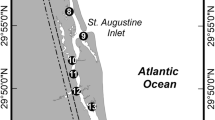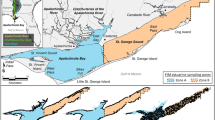Abstract
Coincidental long-term changes in estuarine nekton assemblages and environmental conditions are widely reported. In this study, from a warm-temperate, high salinity, salt marsh-dominated estuary in the southeastern USA, decreases in overall abundance, shifts in species and life stage composition, and changes in seasonal patterns of occurrence coincided with increased water temperature. Biweekly trawl collections in a subtidal creek were made during two 4-year periods separated by more than 30 years. Of the total 111 taxa in the North Inlet estuary, South Carolina, 64% (71) occurred during both the historic (1981–84) and recent (2013–16) periods. The top five species and their proportions of the total annual catches changed between periods. In the recent study period, near-bottom species (Lagodon rhomboides, Bairdiella chrysoura, Litopenaeus setiferus) increased, and pelagic species (Anchoa spp. and Lolliguncula brevis) decreased. The mean abundance of total nekton in the recent period was approximately 50% of historic abundance. Large, but temporary increases in nekton abundance occurred when salinity decreased after major storms. In the recent study period, shifts in the timing of peak abundances from spring to fall, the occurrence of juveniles during winter, and increased diversity suggested responses to significantly warmer winters and summers. Over the 30 year period, the subtidal nekton assemblage transitioned to a state of lower abundance and different composition. Future increases in water temperature, incidences of major storms, and modifications of estuarine habitats due to rising sea level could lead to additional changes in the fauna of warm-temperate estuaries.





Similar content being viewed by others
References
Able, K.W., and M.P. Fahay. 2010. Ecology of estuarine fishes, temperate waters of the western North Atlantic. Baltimore: The Johns Hopkins University Press.
Allen, D.M., W.S. Johnson, and V. Ogburn-Matthews. 1995. Trophic relationships and seasonal utilization of salt-marsh creeks by zooplanktivorous fishes. Environmental Biology of Fishes 42: 37–50.
Allen, D.M., S.S. Haertel-Borer, B.J. Milan, D. Bushek, and R.F. Dame. 2007. Geomorphological determinants of nekton use of intertidal salt marsh creeks. Marine Ecology Progress Series 329: 57–71.
Allen, D.M., V. Ogburn-Matthews, T. Buck, and E.M. Smith. 2008. Mesozooplankton responses to climate change and variability in a southeastern US estuary (1981-2003). Journal of Coastal Research SI (55): 95–110.
Allen, D.M., Allen, W.B., Feller, R.J., Plunkett, J.S. (2014). Site profile of the North Inlet-Winyah Bay National Estuarine Research Reserve, pp 432. Baruch Institute: University of South Carolina, http://www.baruch.sc.edu/site-profile.
Allen, D.M., V. Ogburn-Matthews, and P.D. Kenny. 2017. Nekton use of flooded salt marsh and an assessment of intertidal creek pools as low-tide refuges. Estuaries and Coasts 40: 1450–1463.
Anderson, M.J., and J. Robinson. 2003. Generalized discriminant analysis based on distances. Australian and New Zealand Journal of Statistics 45: 301–318.
Anderson, M.J., and T.J. Willis. 2003. Canonical analysis of principal coordinates: a useful method of constrained ordination for ecology. Ecology 84: 511–525.
Anderson, M.J., R.N. Gorley, and K.R. Clarke. 2008. PERMANOVA+ for PRIMER: Guide to Software and Statistical Methods. 1st ed. Plymouth: PRIMER-E Ltd..
Araujo, F.G., M.C. Costa de Azevedo, and A.P.P. Guedes. 2016. Inter-decadal changes in fish communities of a tropical bay in southeastern Brazil. Regional Studies in Marine Science 3: 107–118.
Araujo, F.G., S.M. Pinto, L.M. Neves, and M.C. Costa de Azevedo. 2017. Inter-annual changes in fish communities in a tropical bay in southeastern Brazil: What can be inferred from anthropogenic activities? Marine Pollution Bulletin 114 (1): 102–113.
Blaber, S.J.M., S.P. Griffiths, and R. Pillans. 2010. Changes in the fish fauna of a tropical Australian estuary since 1990 with reference to prawn predators and environmental change. Estuarine, Coastal, and Shelf Science 86: 692–696.
Bretsch, K., and D.M. Allen. 2006. Tidal Migrations of Nekton in Salt Marsh Intertidal Creeks. Estuaries and Coasts 29 (3): 474–486.
Buchsbaum, R., and J.C. Powell. 2008. Symposium review: Long-term shifts in faunal assemblages in eastern North American estuaries: A review of a workshop held at the biennial meeting of the Coastal and Estuarine Research Federation (CERF), November 2007, Providence, Rhode Island. Reviews in Fish Biology and Fisheries 18: 447–450.
Cabral, H.N., M.J. Costa, and J.P. Salgado. 2001. Does the Tagus estuary fish community reflect environmental changes? Climate Research 18: 119–126.
Collie, J.S., A.D. Wood, and H.P. Jeffries. 2008. Long-term shifts in the species composition of a coastal fish community. Canadian Journal of Fisheries and Aquatic Sciences 65: 1352–1365.
Dahlberg, M.D. 1972. An ecological study of Georgia coastal fishes. Fishery Bulletin 70 (2): 323–353.
Dahlberg, M.D., and E.P. Odum. 1970. Annual cycles of species occurrence, abundance, and diversity in Georgia estuarine fish populations. The American Midland Naturalist 83 (2): 382–392.
Dame, R., M. Alber, D. Allen, M. Mallin, C. Montague, A. Lewitus, A. Chalmers, R. Gardner, C. Gilman, B. Kjerfve, and J. Pinckney. 2000. Estuaries of the south Atlantic coast of North America: their geographical signatures. Estuaries 23 (6): 793–819.
DeLancey, L., E. Wenner, and J. Jenkins. 2008. Long-term trawl monitoring of white shrimp, Litopenaeus setiferus (Linnaeus), stocks within the ACE Basin National Estuarine Research Reserve, South Carolina. Journal of Coastal Research SI (55): 193–199.
Ecoutin, J.M., M. Simier, J.J. Albaret, R. Lae, and L. Tito de Morais. 2010. Changes over a decade in fish assemblages exposed to both environmental and fish constraints in the Sine Saloum estuary (Senegal). Estuarine, Coastal, and Shelf Science 87: 284–292.
Fodrie, F.J., K.L. Heck, S.P. Powers, W.M. Graham, and K.L. Robinson. 2010. Climate-related, decadal-scale assemblage changes of seagrass-associated fishes in the northern Gulf of Mexico. Global Change Biology 16: 48–59.
Garcia, A.M., J.P. Vieira, K.O. Winemiller, and A.M. Grimm. 2004. Comparison of 1982-1983 and 1997-1998 El Nino effects on the shallow-water fish assemblage of the Patos Lagoon estuary (Brazil). Estuaries 27 (6): 905–914.
Genner, M.J., D.W. Sims, V.J. Wearmouth, E.J. Southall, A.J. Southward, P.A. Henderson, and S.J. Hawkins. 2004. Regional climatic warming drives long-term community changes of British marine fish. Proceedings of the Royal Society of London B 271: 655–661.
Hare, J.A., and K.W. Able. 2007. Mechanistic links between climate and fisheries along the east coast of the United States: explaining population outbursts of Atlantic croaker (Micropogonias undulatus). Fisheries Oceanography 16: 31–45.
Hoese, H.D., and R.H. Moore. 1998. Fishes of the Gulf of Mexico: Texas, Louisiana, and adjacent waters. 2nd ed. College Station: Texas A&M University Press.
Howell, P., and P.J. Auster. 2012. Phase shift in estuarine finfish community associated with warming temperatures. Marine and Coastal Fisheries: Dynamics, Management, and Ecosystem Science 4: 481–495.
Johnson, W.S., D.M. Allen, M.V. Ogburn, and S.E. Stancyk. 1990. Short-term predation responses of bay anchovies, Anchoa mitchilli, to zooplankton prey availability. Marine Ecology Progress Series 64: 55–68.
Johnson, C.R., S.C. Banks, N.S. Barrett, F. Cazassus, P.K. Dunstan, G.J. Edgar, S.D. Frusher, C. Gardner, M. Haddon, F. Helidoniotis, K.L. Hill, N.J. Holbrook, G.W. Hosie, P.R. Last, S.D. Ling, J. Melbourne-Thomas, K. Miller, G.T. Pecl, A.J. Richardson, K.R. Ridgway, S.R. Rintoul, D.A. Ritz, D.J. Ross, J.C. Sanderson, S.A. Shepherd, A. Slotwinski, K.M. Swadling, and N. Taw. 2011. Climate change cascades; shifts in oceanography, ranges, and subtidal marine community dynamics in eastern Tasmania. Journal of Experimental Marine Biology and Ecology 400 (1–2): 17–32.
Laughlin, R.A., and R.J. Livingston. 1982. Environmental and trophic determinants of the spatial/temporal distribution of the brief squid (Lolliguncula brevis) in the Apalachicola estuary (North Florida, USA). Bulletin of Marine Science 32 (2): 489–497.
Livingston, R.J. 2015. Climate change and coastal ecosystems; long-term effects of climate and nutrient loading on trophic organization, 524. Boca Raton: CRC Press.
Livingston, R.J., G.J. Kobylinski, F.G. Lewis, and P.F. Sheridan. 1976. Long-term fluctuations of epibenthic fish and invertebrate populations in Apalachicola Bay, Florida. Fishery Bulletin 74 (2): 311–321.
Lopez-Rasgado, F.J., S.Z. Herzka, P. Del-Monte-Luna, E. Serviere-Zaragoza, E.F. Balart, and S.E. Lluch-Cota. 2012. Fish assemblages in three arid mangrove systems of the Gulf of California: Comparing observations from 1980 and 2010. Bulletin of Marine Science 88 (4): 919–945.
Matern, S.A., P.B. Moyle, and L.C. Pierce. 2002. Native and alien fishes in a California estuarine marsh: Twenty-one years of changing assemblages. Transactions of the American Fisheries Society 131: 797–816.
O'Connell, M.T., R.C. Cashner, and C.S. Schielbe. 2004. Fish assemblage stability over fifty years in the Lake Pontchartrain estuary; Comparisons among habitats using canonical correspondence analysis. Estuaries 27 (5): 807–817.
Ogburn-Matthews, V., and D.M. Allen. 1993. Interactions among some dominant estuarine nekton species. Estuaries 16 (4): 840–850.
Possamai, B., J.P. Vieira, A.M. Grimm, and A.M. Garcia. 2018. Temporal variability (1997-2015) of trophic fish guilds and its relationships with El Nino events in a subtropical estuary. Estuarine, Coastal, and Shelf Science 201: 145–154.
Ribeiro, J., C.C. Monteiro, P. Monteiro, L. Bentes, R. Coelho, J.M.S. Goncalves, P.G. Lino, and K. Erzini. 2008. Long-term changes in fish communities of the Ria Formosa coastal lagoon (southern Portugal) based on two studies made 20 years apart. Estuarine, Coastal, and Shelf Science 76: 57–68.
Shenker, J.M., and J.M. Dean. 1979. The utilization of an intertidal salt marsh creek by larval and juvenile fishes: abundance, diversity and temporal variation. Estuaries 2 (3): 154–163.
Smith, K.L., I.C. Flores, and C.M. Pringle. 2008. A comparison of current and historical fish assemblages in a Caribbean island estuary: conservation value of historical data. Aquatic Conservation: Marine and Freshwater Ecosystems 18: 993–1004.
Sobocinski, K.L., R.J. Orth, M.C. Fabrizio, and R.J. Latour. 2013. Historical comparison of fish community structure in lower Chesapeake Bay seagrass habitats. Estuaries and Coasts 36: 775–794.
Subrahmanyam, C.B., and C.L. Coultas. 1980. Studies on the animal communities in two north Florida salt marshes Part III. Seasonal fluctuations of fish and macroinvertebrates. Bulletin of Marine Science 30 (4): 790–818.
Subrahmanyam, C.B., and S.H. Drake. 1975. Studies on the animal communities in two north Florida salt marshes Part I. Fish communities. Bulletin of Marine Science 25 (4): 445–465.
Taylor, J.C., W.A. Mitchell, J.A. Buckel, H.J. Walsh, K.W. Shertzer, G.B. Martin, and J.A. Hare. 2009. Relationships between larval and juvenile abundance of winter-spawned fishes in North Carolina, USA. Marine and Coastal Fisheries: Dynamics, Management, and Ecosystem Science 1: 11–20.
Upchurch, S., and E. Wenner. 2008. Fish and decapod crustacean assemblages from the Ashepoo-Combahee-Edisto basin, South Carolina. Journal of Coastal Research SI (55): 200–213.
van der Veer, H.W., R. Dapper, P.A. Henderson, A.S. Jung, C.J.M. Philippart, J.I. Witte, and A.F. Zuur. 2015. Changes over 50 years in the fish fauna of a temperate coastal sea: Degradation of trophic structure and nursery function. Estuarine, Coastal, and Shelf Science 155: 156–166.
Acknowledgments
Special thanks go to (in alphabetical order) W. Allen, L. Barker, T. Buck, K. Dean, K. Gruenhagen, E. Haffey, M. Mace, B. McCutchen, W. Michener, C. Ryan, T. Swanson, T. Swatzel and the many dozens of other staff, students, and volunteers who assisted with field collections, sample processing, and data management.
Funding
The historic period study was supported by National Science Foundation grant DEB 8012165 and the recent period study was supported by the North Inlet-Winyah Bay National Estuarine Research Reserve.
Author information
Authors and Affiliations
Corresponding author
Ethics declarations
This research was conducted in accordance with the guidelines set forth in the University of South Carolina IACUC Animal Care and Use Protocol no. 2338-101197-030317.
Additional information
Communicated by Matthew D. Taylor
Electronic Supplementary Material
ESM 1
(PDF 51 kb).
Rights and permissions
About this article
Cite this article
Kimball, M.E., Allen, D.M., Kenny, P.D. et al. Decadal-Scale Changes in Subtidal Nekton Assemblages in a Warm-Temperate Estuary. Estuaries and Coasts 43, 927–939 (2020). https://doi.org/10.1007/s12237-019-00692-1
Received:
Revised:
Accepted:
Published:
Issue Date:
DOI: https://doi.org/10.1007/s12237-019-00692-1




